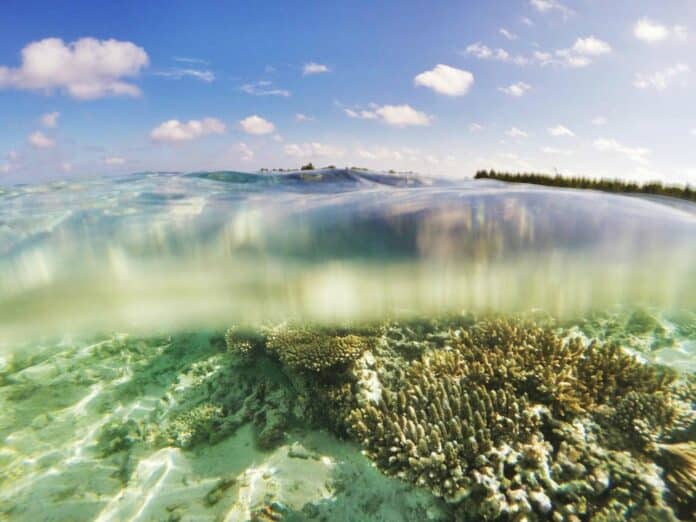Seabed pockmarks are among the most prominent morphologic structures in the oceans. They are usually interpreted as surface manifestations of hydrocarbon fluids venting from sediments. Individual pockmarks and large pockmark fields containing hundreds to many thousands of features have been reported from around the globe across a range of marine and lacustrine provinces.
How exactly this takes place has been scarcely investigated so far?
Scientists from Kiel University studied seafloor craters-like depressions in the North Sea, discovering they are linked to porpoise and sand eel habitats. This reveals the role of vertebrates in shaping the seafloor.
Pockmarks, or thousands of crater-like depressions in the sediment, are scattered across the North Sea bottom. They most likely number in the millions throughout the global ocean. It is generally accepted in science that they are created by fluid discharge, such as groundwater or the greenhouse gas methane. Scientists are still baffled by these pockmarks because many defy the explanation of fluid seepage. For the first time, the findings demonstrate that these depressions are not the product of increasing fluids but rather directly relate to the habitat and behavior of porpoises and sand eels.
Dr Jens Schneider von Deimling, lead author of the current study and geoscientist at Kiel University, said, “Our high-resolution data provide a new interpretation for the formation of tens of thousands of pits on the North Sea seafloor, and we predict that the underlying mechanisms occur globally, but have been overseen until now.”
Scientists examined the seafloor in the North Sea off Heligoland down to centimeters. They also analyzed the behavior of vertebrates, such as porpoises, in their analyses.
The depressions on the seafloor in the German Bight are likely formed by porpoises and other animals hunting for food, with bottom currents helping to shape them. Sand eels are popular with the fishing industry and consumed in large quantities by porpoises.
Dr Anita Gilles of the TiHo-Institute for Terrestrial and Aquatic Wildlife Research (ITAW) said, “From analyses of the stomach contents of stranded porpoises, we know that sand eels are an important food source for the North Sea population.”
The study revealed that marine mammals create pits in the seafloor while hunting buried sand eels, similar in appearance to pockmarks but shallower.
Geoscientist Schneider von Deimling said, “The formation mechanism of these pits, as we call them, probably also explains the existence of numerous crater-like depressions on the seafloor worldwide, which have been misinterpreted as the result of methane gas leaks.”
Scientists discovered 42,458 shallow pits in the North Sea with an average depth of 11 centimeters. These pits, differing in morphology from traditional pockmarks, are created by marine mammals hunting sand eels. Schneider von Deimling, an expert in seafloor mapping, methane seepage, and pockmarks, did not believe the depressions in the German Bight were caused by rising fluids.
Scientists noted, “We had to develop an alternative hypothesis for the formation. This allowed us to predict where potential porpoise feeding sites are, and that is exactly where we found the pits – always close to sandeel habitats. Our extensive and multidisciplinary data analysis now provides a conclusive explanation for our harbor porpoise pits hypothesis.”
The scientists used an interdisciplinary approach, combining geological studies, sonar measurements, and analyses of vertebrate behavior. By examining millions of echo soundings from German research vessels, they identified shallow pits on the seafloor with centimeter precision. Special echosounding methods allowed them to study the seafloor and detect features such as free methane gas.
Dr. Jacob Geersen, co-author of the study, said, “Analyzing the data, collected by research vessels over thousands of nautical miles, was a mammoth task. With modern methods, such structures can be automatically detected and characterized in acoustic data sets and analyzed in large data sets.”
The research team suggests that initial feeding pits created by vertebrates become nuclei for larger cavities through scouring, impacting the seafloor globally. In the study area alone, holes cover nine percent of the seafloor, with an estimated 773,369 tons of sediment deposited over 1,581 km², equivalent to the weight of half a million cars. This discovery has broader implications for benthic ecosystems.
Schneider von Deimling said, “Our results have far-reaching implications from a geological and biological perspective. They can help to assess the ecological risks associated with the expansion of renewable energies in the offshore sector and thus improve marine environmental protection.”
Journal Reference:
- Schneider von Deimling, J., Hoffmann, J., Geersen, J. et al. Millions of seafloor pits, not pockmarks, induced by vertebrates in the North Sea. Commun Earth Environ 4, 478 (2023). DOI: 10.1038/s43247-023-01102-y
